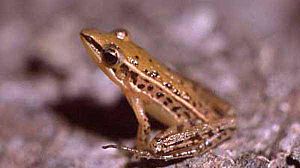Golden-backed frogs facts for kids
Quick facts for kids Golden-backed frogs |
|
|---|---|
 |
|
| Hylarana macrodactyla | |
| Scientific classification |
|
| Kingdom: | Animalia |
| Phylum: | Chordata |
| Class: | Amphibia |
| Order: | Anura |
| Family: | Ranidae |
| Genus: | Hylarana Tschudi, 1838 |
| Type species | |
| Hylarana erythraea Schlegel, 1837
|
|
| Diversity | |
| 4 species | |
| Synonyms | |
|
|
Hylarana is a group of frogs, also known as golden-backed frogs. These frogs live in the warm, wet areas of Asia, called the tropics. For a long time, scientists thought there were many different kinds of Hylarana frogs, maybe even up to 96 species! But after studying them more closely, they now agree that there are only four true species in the Hylarana group.
Contents
What Do Hylarana Frogs Look Like?
Hylarana frogs can be different sizes. Male frogs are usually about 27 to 85 millimeters (about 1 to 3.3 inches) long from their nose to their bottom. Female frogs are a bit bigger, measuring about 38 to 92 millimeters (about 1.5 to 3.6 inches) long.
These frogs have oval-shaped nostrils with a small piece of skin on top. Their eardrum (which is like our ear) is easy to see and isn't covered by skin. They also have special vomerine teeth in the roof of their mouth and a small "parietal eye" on their head, which can sense light. Their back feet have webbing between the toes, which helps them swim, but their front feet do not.
Where Do Golden-Backed Frogs Live?
The four species of Hylarana frogs that scientists recognize today live in southern and southeast Asia. This includes countries like Sri Lanka, parts of India, Nepal, southern China, Taiwan, the Philippines, and Papua New Guinea.
Before scientists re-examined the group, they thought Hylarana frogs lived in an even wider area. This included places like Northern Australia and even tropical Africa. But now we know that the true Hylarana species are found only in specific parts of Asia.
How Scientists Classify Hylarana Frogs
Hylarana frogs belong to a larger group called Raninae, which is a subfamily of true frogs. All true frogs are part of the family Ranidae.
The name Hylarana comes from two New Latin words: hyle, meaning "wood" or "forest," and rana, meaning "frog." So, it basically means "forest frog."
For a while, scientists thought Hylarana was just a smaller group (a subgenus) within the larger frog group called Rana. But in 2005, they decided Hylarana was its own main group, or genus. Then, in 2006, scientists started to split the Hylarana group even further into many new genera (plural of genus).
In 2015, a group of scientists led by Oliver looked very closely at Hylarana again. They decided that only four species truly belonged to Hylarana. All the other frogs that were once called Hylarana were moved to different new groups, such as Abavorana, Amnirana, Chalcorana, Humerana, Hydrophylax, Indosylvirana, Papurana, Pulchrana, and Sylvirana.
Species of Hylarana
As of now, scientists agree that these four species are the only true Hylarana frogs:
- Hylarana erythraea (Schlegel, 1837) - also known as the common green frog or red-eared frog.
- Hylarana macrodactyla Günther, 1858 - also called the Guangdong frog or three-striped grass frog.
- Hylarana taipehensis (Van Denburgh, 1909) - known as the two-striped grass frog.
- Hylarana tytleri Theobald, 1868
There are also a few other frog species that scientists are still trying to figure out where they belong. They were once thought to be Hylarana but might be moved to other groups in the future:
- "Hylarana" attigua (Inger, Orlov, and Darevsky, 1999)
- "Hylarana" celebensis (Peters, 1872)
- "Hylarana" chitwanensis (Das, 1998)
- "Hylarana" garoensis (Boulenger, 1920)
- "Hylarana" lateralis (Boulenger, 1887)
- "Hylarana" latouchii (Boulenger, 1899)
- "Hylarana" margariana Anderson, 1879
- "Hylarana" montivaga (Smith, 1921)
- "Hylarana" persimilis (Van Kampen, 1923)
Related pages
See also
 In Spanish: Hylarana para niños
In Spanish: Hylarana para niños

